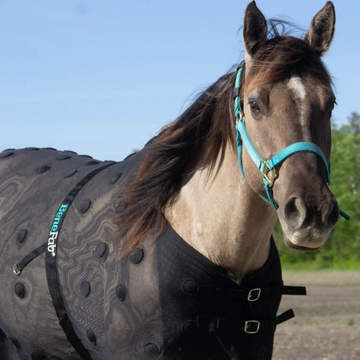DSLD is a disease that affects the connective tissue of the lower limbs in Peruvian Pasos, Paso crosses, Arabians, Saddlebreds, Quarter Horses, and Thoroughbreds. One of the most known and prominent symptoms is dropped fetlocks. It always appears in either both hind legs, both front legs or all the legs. Symptoms usually start at age 10 and it is believed to be a genetic disorder. It can affect the entire horse, but usually starts in the fetlocks first.

Symptoms to look for:
- Heat and swelling in the suspensory branches or fetlock area
- Digging holes to stand in with toes pointing downward toward the hole
- Pain with palpation of the suspensory ligament
- Laying down frequently followed by trouble getting up
- Back pain and soreness
- Stumbling and tripping
- Irritability; change in attitude
- Very loose skin
- Change in horse’s gait
- Sudden weight loss
When the disease progresses pain is constant and the horses will become more coon footed, post legged, bucked kneed, and suffer from weight loss over time. DSLD is very painful for the horse and pain relief is often needed on a daily basis.
Diagnosis Options:
- The fetlock joints are "flex tested" and an ultrasound of the suspensory ligaments is taken. DSLD horses tend to fail the flex test in two or more legs.
- Blood is drawn and tested for iron and ferritin. A horse with DSLD will have high levels of iron and possible low levels of magnesium.
- A tissue analysis may be performed at time of necropsy. The disease can be confirmed through tissue testing.
The typical treatment for a DSLD horse is supporting the limb by means of various shoeing and bandaging techniques, reduction of exercise, and pain relievers as needed. Unfortunately, no treatment has been shown to be effective in stopping the disease’s progression. Euthanasia is inevitable.
For those affected, there are many options to help ease the discomfort caused by this unfortunate disease, in addition to proper shoeing and bandaging techniques. The
Smart QuickWraps could be a relieving addition to a horse in any stage of DSLD. The ceramic-infused wraps help by stimulating blood circulation and reducing inflammation, ultimately soothing pain. In addition to the ceramic therapy, the incorporated magnets over key acupressure points help to draw more blood to the area, which may increase the healing rate of tissue damage.
The dual-therapy combo helps to relieve pain at the deep-tissue level, but the wraps can also help on a structural level – they fit to the form of the fetlock and can be tightened accordingly to assist in holding the leg’s proper form. This may help relieve some of the extra strain put on the ligaments from degeneration, and provide support.























